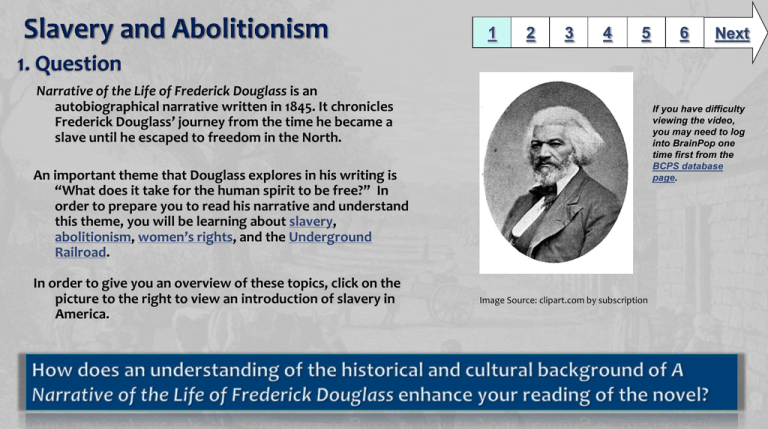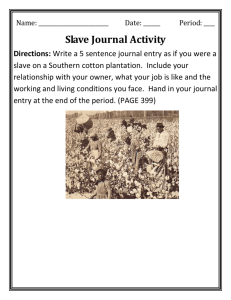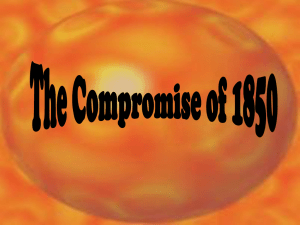
1
2
3
4
5
Narrative of the Life of Frederick Douglass is an
autobiographical narrative written in 1845. It chronicles
Frederick Douglass’ journey from the time he became a
slave until he escaped to freedom in the North.
Next
If you have difficulty
viewing the video,
you may need to log
into BrainPop one
time first from the
BCPS database
page.
An important theme that Douglass explores in his writing is
“What does it take for the human spirit to be free?” In
order to prepare you to read his narrative and understand
this theme, you will be learning about slavery,
abolitionism, women’s rights, and the Underground
Railroad.
In order to give you an overview of these topics, click on the
picture to the right to view an introduction of slavery in
America.
6
Image Source: clipart.com by subscription
1
2
3
4
5
6
Next
You will use these resources to complete the activity on Slide 3:
Slavery:
•
•
•
•
•
•
•
•
•
The Triangular Trade and the Middle Passage (video)
Slave Memories
Virtual Tour of Slave Quarters
Interview of a Former Slave (video)
Slave and Free Soil Interactive Map
Life of a Household Maidservant
Living Conditions of a Slave
Life as a Free Slave
“Black Codes” Affecting Free Slaves
Abolitionism:
•
•
•
•
•
Abolition Movement
William Lloyd Garrison
William Lloyd Garrison and the Liberator
Abolitionist Movement
Emancipation Proclamation and the 13th Amendment
Womens’ Rights:
•
•
•
•
•
•
•
The Women’s Movement and Abolitionism (video)
Susan B. Anthony
Lucy Stone
Elizabeth Cady Stanton
Lucretia Mott
Women’s Suffrage (BrainPop video)
*NOTE: Go to the BCPS Database page and click on BrainPop,
then return to this slide and click on the video link above.
Declaration of Sentiments and Resolutions
Underground Railroad:
•
•
•
•
•
•
Overview (BrainPop video)
*NOTE: Go to the BCPS Database page and click on BrainPop,
then return to this slide and click on the video link above.
Overview (article)
Harriet Tubman
Map of escape routes
Aboard the Underground Railroad
Using Quilts as Codes (video)
1
2
3
4
5
Use this graphic organizer to take notes
about slavery, abolitionism, women’s
rights, and the Underground Railroad
using the information sources on Slide 2.
You will be using your notes to complete
the Assessment Activity on Slide 4.
Image Source: www.pics4learning.com
6
Next
1
2
3
4
5
Now you will compose a journal entry using the
notes on your graphic organizer.
Write a journal entry from the point of view of a
citizen deciding whether to aid slaves in their
escape OR write from the point of view of a
slave contemplating escape.
Be sure to use information from your graphic
organizer to make your journal entry sound
accurate and authentic. Carefully read the Scoring
Rubric so that you know how you will be assessed.
Image Source: www.pics4learning.com
6
Next
1
2
3
Further explore the topics you have been
studying by completing these interactive
simulations.
Image Source: www.scholastic.com
Image Source: www.mission-us.org
4
5
6
Next
1
2
3
4
5
6
Grade Level and Content Area: GT 8 Language Arts
Time Frame: 1-2 days
Common Core State Standards
Reading: CCRA.R.1. Read closely to determine what the text says explicitly and to make logical
inferences from it; cite specific textual evidence when writing or speaking to support conclusions
drawn from the text.
Writing:
CCRA.W.7. Conduct short as well as more sustained research projects based on focused
questions, demonstrating understanding of the subject under investigation.
ELA-Literacy.W.8.3 Write narratives to develop real or imagined experiences or events using
effective technique, relevant descriptive details, and well-structured event sequences.
Standards for the 21st Century Learner
1.1.6 Read, view, and listen for information presented in any format (e.g. textual, visual, media,
digital) in order to make inferences and gather meaning.
2.1.3 Use strategies to draw conclusions from information and apply knowledge to curricular
areas, real-world situations, and further investigations.
ISTE NETS Standards for Students
3. Research and Information Fluency: Students apply digital tools to gather, evaluate, and use
information.
b. Locate, organize, analyze, evaluate, synthesize, and ethically use information from a variety
of sources and media.
4. Critical Thinking, Problem Solving, and Decision Making: Students use critical thinking skills to
plan and conduct research, manage projects, solve problems, and make informed decisions
using appropriate digital tools and resources. c. Collect and analyze data to identify solutions
and/or make informed decisions.
Differentiation strategies for this lesson:
More challenging readings are indicated on Slide 2 with a gold star.
Direct students to use learning tools included in our BCPS-licensed
databases, such as: audio read-aloud, labeled reading levels/Lexiles, and
embedded dictionaries.
Learning Styles addressed in this lesson:
Visual, Auditory, Reflective, Global, Analytical
Notes to the teacher:
Collaborate with your school library media specialist to implement
this lesson.
If students complete the Flight to Freedom simulation on Slide 5,
remind them to use their external password when registering.
Inform students of the following:
Articles may cover more than one topic, and students may need to write
notes in more than one square of their organizer while completing a
reading
Links provided about slavery represent differing points of view as each
slave lived under different conditions and had different life experiences
that shaped their opinions
Some of the primary documents include vocabulary that would not be
considered politically correct today, but that is used in a historical
context and reflects vocabulary used during the time period being
studied.
Last updated: July 2014
Created by Amy L. Samay, Library Media Specialist Intern
BCPS Slam Dunk Research Model, Copyright 2013, Baltimore County Public Schools, MD, all rights reserved. The models may be used for educational, non-profit school use only.
All other uses, transmissions, and duplications are prohibited unless permission is granted expressly. This lesson is based on Jamie McKenzie’s Slam Dunk Lesson module.


